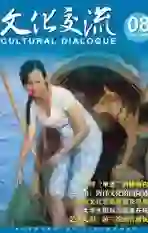一纸莲花话弘一
2013-04-29巫少飞
巫少飞



日前,衢州市衢江区莲花镇莲花村82岁的胡济昌拿出一张根据其记忆所画的当地莲花寺的平面图,说:“弘一法师(李叔同)曾居住莲花寺,在莲花村有好友胡嘉友,而胡嘉友就是我的叔叔。我生活在莲花镇好多年,花费长时间画了张当年的莲花寺平面图,只是觉得对历史应有所记录。”老人的一番话,牵出了一段轶事史料。
莲花之缘
1918年夏,艺术大师李叔同在杭州虎跑定慧寺出家,法号弘一。他本想在湖上见证菩提,不想俗事纷扰无法安静。1920年农历八月初,弘一法师托人新觅闭关修学之地—富阳新登贝山灵济寺。
月余,已移锡衢县莲花寺就任住持的原定慧寺德渊法师致信弘一法师,礼请他“往居襄助一臂之力”,以整饬寺务。于是,弘一法师便前往,在盈川舍舟登岸,凭吊了初唐四杰之一杨炯的祠堂后,再步行八里,叩开莲花寺的山门。
1923年,弘一法师再次来到莲花寺,并在附近的全旺三藏寺、峡口南湖寺和衢城内大中祥符寺小住。弘一法师最重要的佛学著作《四分律比丘戒相表记》初稿就在莲花寺完成。此著作将中断了700多年的南山律宗发扬光大,奠定了他在中国佛学史上的地位,被弟子尊为南山律宗第十一代世祖。莲花寺的地位应当得到重视。
莲花之谊
弘一法师在衢县时间并不十分长,却有不少僧俗弟子,如程本一、胡嘉有、毛善力、吴南章、宽愿和尚等。弘一法师留给这些弟子较多诗文,颇有研究价值,像《汪居士传》《汪居士传补遗》《大中祥符朗日禅师塔铭》《比丘律藏函题词》《旭光室跋》《崔母往生传》《慈说》等。其中《慈说》是赠给关门弟子、江山毛善力的,同时还相赠两件家珍:一是他在日本上野美术学校毕业时的奖品—插花瓷瓶;一是他在虎跑寺出家时剃下的一包须发,可见情谊之深。后来,弘一法师到福建,还应毛善力请求书写了“有恒堂”“智忍堂”及十多幅屏条。
获弘一手书卷轴者,还有吴子弓、项槐、汪梦松、汪半僧、仇星农、程本一、徐佐才、胡嘉友、汪子佩、杜宝光等。此外,弘一法师曾有多帧佛号、箴言的书法作品留在衢州。上世纪30年代,程本一等人在衢县设“平凡画会”“乐群乐社”,其所用《正则洋画讲义》等资料均为弘一所赠。美术家刘海粟也曾从衢县佛寺求得弘一法师墨宝。
弘一离开衢县时,与僧众居士合影一张,扩印两张,分别悬于祥符寺客堂及莲华寺方丈室。合影中居士有汪半僧、汪梦松、汪张黻、项槐等。
莲花之佛
衢州市博物馆现藏有一件国家级珍贵文物—汉白玉释迦牟尼佛像。此尊趺坐佛像以汉白玉雕刻而成,高56厘米,重达40公斤。像的脸形俏丽,双目微启下视,嘴角上翘呈微笑状;身着宽袖长袍,腰身纤细;右肩臂裸露,长袍褶皱处有金线描之;右手自然下垂,左手曲至胸前,掌心朝上;整体给人以优美、协调、宁静的感觉,堪称雕刻艺术中的珍品。
旧《衢县志》认为,“(1920年)有僧德渊由虎跑来衢县莲花寺主斯席,邀请戒僧弘一莅坛说法,并有缅甸携来玉佛一座,供养观音堂。”
弘一法师的莲花友人汪梦松有《薜萝庵日志》73册,里面涉及非常多弘一法师的衢县事宜。该日志说,缅甸玉佛确为弘一法师带来,后在战乱年代与地藏王菩萨像、济公活佛像及万岁牌、木鱼磬等一起搬抬至明果寺。
该玉佛至今还有些未解之谜。中国现存佛像造型大都给人以庄重感,而该玉佛却更多体现了民间少女风情。这种形象玉佛是缅甸朋友所赠,还是杭州定慧寺原有?是与佛教宗派有关,还是根据弘一法师要求所雕?这些都是谜。而这些“谜”正是价值所在。
莲花之游
弘一法师两次来衢县,曾有广泛交游。
衢州文化人沈华龙告诉笔者一事:大约1983年,衢州文物普查队在莲花镇曾从汪梦松后人手中得到一石,上刊小楷诗一首:“千峰顶上一间屋,老僧半间云半间。昨夜云随风雨去,到头不似老僧闲。”落款是“归宗芝庵住持野昉句”“昙昉演音”。石的反面有汪梦松20年后的题记一篇:“弘一上人癸亥冬书赠二石,一曰‘放下二字,一即此石。上人举动多美化,余甚珍爱,寇劫未及,或有佛力护持也。癸未浮若”。
“浮若”即汪梦松的字。弘一法师曾为之写过两文:《汪居士传》《汪居士传补遗》。受赠二石,与《薜萝庵日志》所记一致。
弘一法师留在衢县的经书有一部《大佛顶首楞严经合辙》,系天启元年(1621)木刻本。经书第一册封面上有弘一法师1923年题字及朱印“演音”。此书另有汪梦松题字:“癸亥冬弘一法师以赐梦松。”汪梦松精书画篆刻诸术,为弘一法师篆刻过“演音”诸印。
弘一法师也赠汪梦松两枚印章,一枚是弘一法师自刻“演音”,另一枚是国学大师马一浮为弘一法师刻的“了事凡夫”。边款有汪梦松题识:“此印马一浮居士为弘一上人刊……”
衢州文化人刘国庆编著《衢州书画人物录》,提及莲花村胡嘉友。胡嘉友为汪梦松一手携教。弘一法师对胡嘉友指事曲喻,欲劝其皈信佛法,然胡母不同意。
据莲花镇老人说,莲花寺原有一放生池,池边有一方刻石,上书“莲花池”,据说是弘一法师的手迹。老一辈人听父辈说,弘一法师在莲花寺时,常在池边观赏游鱼,或徜徉于花径、菜垄间,过着优游的生活。传闻弘一法师在莲花寺时,他往昔的日籍爱姬循迹至此,可寺楼掩关,决然不相见。
莲花之史
据旧《衢县志》载,五代时,芝溪流经现莲花镇时,开五色莲花,异香袭人,故称。
莲花寺,宋建隆中始建。康熙《西安县志》载:清初莲花寺仅为一茅庵,只能容膝。康熙乙巳(1665),云间乾敏和尚宿莲花寺,寒夜恍惚听觉莲花溪有堕水者号呼声,发愿建石桥于溪上,四年始落成;桥下改放生池;寺后有涌泉一泓。这些都是当年文士秀才如费士桂、范珏、陈鹏年辈诗文中的胜景胜迹。
乾隆二十四年(1759),僧悟光因石桥倾圮募缘重建。嘉庆十五年(1810),僧永传对莲花寺作规模最大的一次增建,其中方丈禅堂最为宏敞,前后经9年才完工。彼时,寺僧达500余人。道光年间,有位铁舟和尚来到莲花寺,曾赋诗多首。弘一法师来莲花寺时,曾见这些诗留于佛楼壁间,对此称赏。
如今莲花寺只剩下一面颓墙,墙石上隐约可见“卍”字符号。
莲花之图
弘一法师盛赞莲花寺:“前临溪流,上驾石梁五虹,名胜甲东浙。”
胡济昌老人提供的莲花寺平面图,面积达7000多平方米。纵轴线上依次是山门、四大金刚殿、烧纸场、大雄宝殿、观音堂等。纵轴线两侧建有相对称的院落、屋宇,有方丈室、会客厅及其他僧房。金刚殿、大雄宝殿、方丈室、会客室、贮藏室均为三间,山门有两进。整座寺院“殿宇宏敞、璎珞光明”。
寺院内以樟树为主,小路砌以鹅卵石,山门左侧还有一间地藏王殿。老人告诉笔者:寺院正门悬“莲华寺”金字匾。寺院内有小溪穿过。小溪南面有竹林;竹林偏西有许多僧墓,砌以石板石条,夏天村里人常在此乘凉。小溪北面以寺田为主。寺田东面有一法乳泉,周围设有石桌石凳,供人休息。老人说,当年因为莲花寺盛名而带来了许多商机。寺边街道上竟有四家大店经营南货、布匹、粮食等,饴糖店、茶馆、小吃摊比邻而立。旧时的莲花镇亦是农副产品的集散地。
老人回忆,1936年秋天,莲花寺金刚殿不幸失火被烧。1956年,因白蚁蛀蚀,寺院东倒西歪,观音堂首告倒塌。莲花镇驻村干部余礼明相告,他小时候读书时还能见到部分寺院旧貌,1980年后彻底塌毁,遗址逐步改建为莲花小学。
老人告诉笔者,近些年,有许多人因仰慕弘一法师,常慕名来莲花镇,可莲花寺已经荡然无存,故凭记忆画下来,希望能存文化的一方之史。
(除署名外,本文图片由作者提供)
Master Hongyi and Lotus Flower Temple
By Wu Shaofei
The 82-year-old Hu Jichang has a treasure map. A resident of Lotus Flower Village in Qujiang District, Quzhou City in western Zhejiang Province, Hu knows something special: Master Hongyi stayed at Lotus Flower Temple in 1920 and 1923 respectively. Hongyi was the name adopted by Li Shutong (1882-1942) when the scholar, painter, and composer dedicated himself to Buddhism and left the secular world for becoming a full-time monk. Hu Jichang recalls that while staying at Lotus Flower Temple, Master Hongyi made friends with Hu Jiayou, who was Hu Jichangs paternal uncle. Hu Jichang has lived in Lotus Flower Village for a long while. Though the temple is no more, the map he re-created shows details of the temple as he remembers it.
In the summer of 1918, Li Shutong converted to Buddhism and became a monk at Dinghui Temple at Tiger Spring, a scenic spot near the West Lake in Hangzhou. He had intended to spend the rest of his life there contemplating Buddhism and seeking nirvana. The outside world was just a step away and he was frequently disturbed. In the summer of 1920, he went to Lingji Temple in Fuyang, a rural county of Hangzhou. After a month there, he received a letter from Master Deyuan, who had stayed at Dinghui Temple in Hangzhou and now served as the abbot of Lotus Flower Temple in Quxian County in western Zhejiang. The abbot invited Master Hongyi to help him at the temple. Master Hongyi obliged. In 1923, Master Hongyi visited Lotus Flower Temple again. During this period, he stayed briefly at three other Buddhist temples in close neighborhood. It was at Lotus Flower Temple that Master Hongyi finished a draft of an important Buddhism dissertation. The dissertation restored the teachings of the Commandments Sect of Nanshan, which had been out of fashion for more than 700 years by then. This work established Master Hongyi as an important figure in the history of Chinese Buddhism. The disciples of the sect worship him as the 11th-generation master of the sect. This is partly why Lotus Flower Temple is important: the master underwent a transformation there. He morphed from a Zen disciple into a believer of another sect.
Master Hongyi did not stay for a long time at the temple, but he had some disciples studying under him in the village and he made quite a few friends there. He gave these local disciples his essays, inscriptions, seals, books and poems. Mao Shanli was the last disciple the master had during his stay at Lotus Flower Temple. The master gave Mao Shanli the manuscript of an essay, a porcelain vase that he had received at the commencement ceremony at an art school in Japan, and the hair he had shaved off when he became a monk in Hangzhou.
Before Master Hongyi left Quxian County, he, monks, and secular devotees took a group photo. One enlarged copy was given to Xiangfu Temple and the other to Lotus Flower Temple.
Quzhou City Museum now has a jade statue of Buddha in its collection. The statue was in Lotus Flower Temple and it is now a cultural relic at the state level. Who brought the Buddha to Lotus Flower Temple remains a mystery. Wang Mengsong, an intimate friend of Master Hongyi, left behind him 73 diaries. Many entries in his diaries are about Master Hongyi in Quxian County. If the entries are correct, the jade statue made in Burma was brought to the temple by Master Hongyi. In the war years, the jade statue and many other treasures of the temple were removed and kept in safety.
However, the jade statue itself remains a mystery. Was it a gift from Burma? Was it owned by Dinghui Temple in Hangzhou? Was it made to the order of Master Hongyi?
Lotus Flower Temple was first built in the Song Dynasty (960-1279). In the early years of the Qing Dynasty (1644-1911), the temple was just a tiny cottage. In 1665, a monk staying at the temple heard someone cry for help at midnight. The monk later swore to have a stone bridge built. It took four years for the bridge to come into being. In 1759, the bridge was rebuilt. In 1810, the temple was expanded after a 9-year construction project. The expanded temple was so spacious that it housed more than 500 monks. Today, only one wall stands.
On the floor map drawn by Hu Jichang, the temple sits in an area of 7,000 square meters. According to Hu, the temple was the center of the village in the past. As Buddhist pilgrims came from afar to the temple, there were many shops on the street outside the temple to cater to their secular and religious needs.
In the autumn of 1936, the Vajra Hall at Lotus Flower Temple burned down. In 1956, the Guanyin Hall collapsed due to the decay brought about by termites. By the 1980s, the temple had become totally ruined. On the site now is a primary school.
